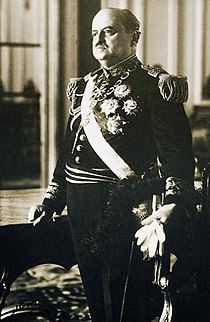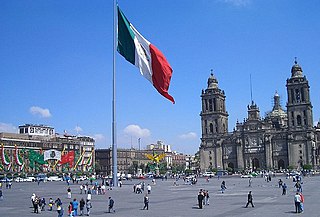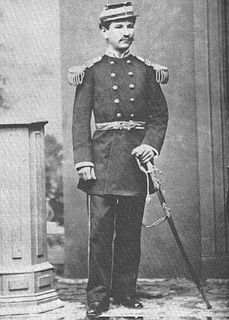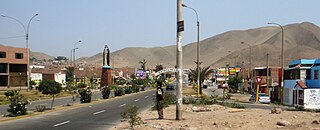
Óscar Raymundo Benavides Larrea was a prominent Peruvian field marshal, diplomat, and politician who served as the 45th and 49th President of Peru.

Lima is a district of Lima Province in Peru. It is, however, not the Central business district of Lima, the country's capital city: this is San Isidro District.

Rímac is a district in the Lima Province, Peru. It lies directly to the north of downtown Lima, to which it is connected by six bridges over the Rímac River. The district also borders the Independencia, San Martín de Porres, and San Juan de Lurigancho districts. Vestiges of Lima's colonial heyday remain today in an area of the Rímac district known as the Historic centre of Lima, which was declared a UNESCO World Heritage Site in 1988. Downtown Rímac District has, like its southern counterpart, its eastern and western sides divided by Jirón Trujillo, which connects to Lima District's Jirón de la Unión through the Puente de Piedra, the oldest bridge in the whole city. Rímac's East side features the Plaza de Acho, the most famous bullfighting arena in South America and one of the most well known in the world.

Located principally in the city centre or Cercado de Lima and Rímac areas, the Historic Centre of Lima is among the most important tourist destinations in Peru.

The historic center of Mexico City, also known as the Centro or Centro Histórico, is the central neighborhood in Mexico City, Mexico, focused on Zócalo or main plaza and extending in all directions for a number of blocks, with its farthest extent being west to the Alameda Central. The Zocalo is the largest plaza in Latin America. It can hold up to nearly 100,000 people.

Interbank is a Peruvian provider of financial services.

The Plaza Mayor or Plaza de Armas of Lima, is the birthplace of the city of Lima, as well as the core of the city. Located in the Historic Centre of Lima, it is surrounded by the Government Palace, Cathedral of Lima, Archbishop's Palace of Lima, the Municipal Palace, and the Palace of the Union.

The Legislative Palace of Peru is the seat of the Congress of Peru, located on the second block of Jiron Ayacucho, on the Plaza Bolivar, in Lima, the capital of Peru. This building is made up of the chamber housing the sessions of congress, the Hemiciclo Raúl Porras Barrenechea chamber, the Hall of the Lost Steps, the offices of the Presidency of the Congress, office of the vice-presidency, the offices of congressional commissions, and the offices of various other parliamentary groups.

The Plaza San Martín is one of the most representative public spaces of the city of Lima, Peru. It is located at the ninth block of Colmena avenue, within the Historic Centre of Lima which was declared a World Heritage Site in 1988 by UNESCO. It is located near the Plaza Mayor of Lima and is connected to it by the Jiron de la Union. Its central monument gives homage to Peru's liberator, José de San Martín.

The Plaza Bolivar is also known as the Plaza of Congress or Plaza of the Inquisition as it is surrounded by the Legislative Palace which is the seat of the Congress of Peru, and the site of the former Tribunal of the Inquisition. It is located in the Barrios Altos neighborhood of the Historic Center of Lima, the capital of Peru. It is located at the second block of Abancay avenue, three blocks east of the Plaza Mayor of Lima.

The Palacio Municipal de Lima or City Hall of Lima is a public building that serves as headquarters of the Metropolitan Municipality of Lima. It is located on the street Portal de Escribanos, block 3 of Jirón de la Unión, and in front of the Plaza Mayor of Lima's historic centre.

Escuela Nacional Superior Autónoma de Bellas Artes del Perú (ENSABAP) is a fine arts school in Lima, Peru. It is located in Barrios Altos, a suburb of Lima District. It was founded in 1918, by President José Pardo y Barreda and Peruvian painter Daniel Hernández, who was its first director. It is located in a monumental building built in the early 1940s.

The Basilica and Convent of San Agustín is located in the historic centre of Lima, in front of the square of the same name, and a few blocks from the Plaza Mayor of the capital. Its care is, since its foundation, run by the Augustinian friars, and belongs to the Province of Our Lady of Grace of Peru.

The Historic Centre of Trujillo is the main urban area and the most important center of development and unfolding in the Peruvian city of Trujillo located in La Libertad Region. The whole process of its original urban fabric is in elliptical shape surrounded by España Avenue that was built in the wake of the Wall of Trujillo. It houses the seat of city government and other important entities in the locality. In the center of this historic urban area is the Plaza de Armas of Trujillo that was the scene of the Spanish founded of the city in 1534 and the proclamation of the independence of Trujillo on December 29, 1820.
The following is a timeline of the history of the city of Lima, Peru.

























